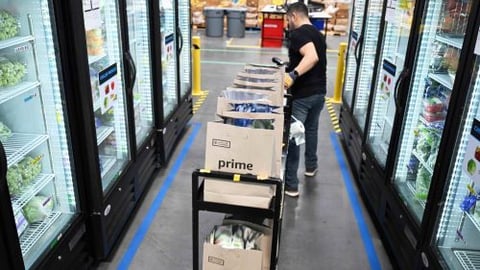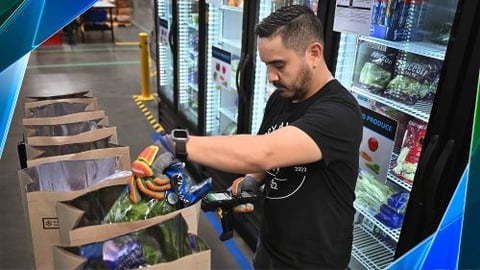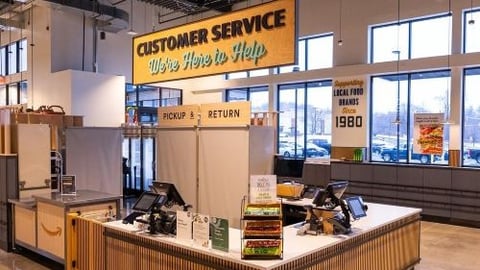The Story Behind Whole Foods Market’s Success
In “Retail Powerhouses: The Whole Foods Market Story,” a session held Jan. 13 during NRF 2025: Retail’s Big Show at New York’s Javits Center, Gina Acosta, Progressive Grocer’s editorial director and associate publisher, sat down with Sonya Gafsi Oblisk, chief merchandising and marketing officer at the Austin, Texas-based natural food retailer, to find out the secrets of its success.
Having started out on the supplier side, with stints at Kraft Foods and the Coca-Cola Co., Oblisk took “a leap of faith to go into retail” by accepting a role at Walmart to work on its private label business, which led to her becoming VP of marketing at Sam’s Club. Now, in her position at Whole Foods, “I like to talk about my role as being the red thread of customer obsession throughout the company,” noted Oblisk, “whether it’s how we think about as sorting our merchandise and the products that we sell, how we are talking to our customers through our communications, or even the digital products that we build and online customer experiences that I’m able to help connect … across a bunch of very, very talented and hardworking teams.”
[PODCAST: Merchandising With Purpose]
Discussing the current retail landscape in terms of prices, she observed, “Always, when I talk to the merchants, my goal is to make Whole Foods as inclusive and as accessible to as many customers as we can, and that means that we offer a full spectrum of price points in all the categories that we do business [in], from opening price point all the way up to our specialty offerings.” She pointed out that in 2024, the company was able to lower prices on 25% – more than 20,000 items – of its product offering. This included permanent price reductions on customers’ most-purchased items and an expanded private label assortment.
However, despite the imperative to lower prices on essentials, Oblisk has noticed a trend in the opposite direction when it comes to niche products. “We actually see customers trading up instead of trading down because they see the exceptional value that we have on some of our more premium” items, she said. “Some of ’em are more specialty items, and they’re seeking that value. It’s not just about lowest, lowest price, but they’re really, as they’re becoming more food aware and understanding more, they’re choosing to capture value where it’s available.”
At the same time, according to Oblisk, Whole Foods is continuing to invest in all of its sustainability programs and in training and developing its associates, known as “team members.” “There’s a lot that happens behind the scenes to make sure that we’re providing a forum where … suppliers can sell [the] highest-quality product as well as where our customers can buy products … aligned with their values,” she said, going on to cite the retailer’s focus on “team member growth and happiness, but particularly on team member growth and ensuring that we are providing paths to team members to have long and fulfilling career paths within Whole Foods.”
One of the ways that the company is doing this is through its apprenticeship program across various areas of the store, “where team members can really dive in to develop specific expertise beyond just the core operations of doing their jobs day in and day out,” explained Oblisk. Whole Foods also offers team members free online continuing-education courses and a career development program.
Referring to Whole Foods’ famous – and ever-evolving – quality standards as “the nucleus of our brand,” Oblisk noted: “It begins and ends with how we buy our items, and we often say what we don’t buy and what we don’t sell is just as important as what we do buy and what we do sell. Currently, we have over 550 ingredients that are [banned] from our stores.” She also took the time to discuss the retailer’s Sourced for Good program, which “is really all about supporting communities, growers and the environment. [T]hrough this program, we’ve been able to give back nearly $10 million to farm workers and growers to support their community, where they actually decide what is meaningful and most important for them and how they spend those dollars.”
[RELATED: Whole Foods Market CEO Tackles How to Be Purpose- and People-Driven]
All of this effort serves to simplify the shopping experience. “We invest a lot of energy and a lot of resources in our quality standards, so quite frankly, the customers don’t have to do the work themselves,” observed Oblisk, who sits on the Quality Standard Steering Committee, along with CEO Jason Buechel.
Given the tech focus of Retail’s Big Show, one of Acosta’s questions was about omnichannel innovation, to which Oblisk replied, “[W]e’re very focused on not only raising the bar on our in-store customer experience, but also doing the same through all of our digital tools, our channels and our shopping experience. One thing we were really excited about this year was the launch of our grocery delivery subscription,” which delivered on the need for value and allowed a new set of customers to experience Whole Foods.
Additionally, through its partnership with parent company Amazon, Whole Foods is “able to expand our products, our offering … beyond our physical stores and our e-commerce business, and also offer them on the core Amazon.com business,” noted Oblisk. “So last year, we were able to do that with our shelf-stable 365 private label products, which was exciting. To me, the best part about it is, as we look at the customers who have bought those items online, most of them live nowhere near a Whole Foods and have never shopped a Whole Foods before.”
Asked what advice she had for grocers on innovating their businesses, Oblisk reminded attendees that “it all starts with the customer, so really listening deeply to your customers. It's not just about collecting data, it’s more so about mining for insights, understanding what those unmet needs are. And then I also always say everybody is best when they're the best version of themselves. So while competition is important … it’s really about dialing up what that customer value proposition is in ways that you’re keeping pace with their evolving set of needs.”
With business-savvy but empathetic execs like Oblisk at the helm, it’s easy to see how Whole Foods has earned – and kept – its reputation as a retail powerhouse.






